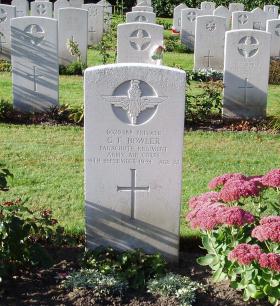George Bowler was born on the 19 January 1922. He enlisted into The Essex Regiment on the 4 November 1940. [1]
In late 1942 he volunteered for Airborne Forces and after completing the selection process at Hardwick Hall, he was sent onto Parachute Course 45 at RAF Ringway. This ran from the 4 to the 13 January 1943, and was a Long Course of two balloon and five aircraft descents (from a Whitley), and consisted of reinforcements for the 1st Parachute Brigade. His Parachute Instructors comments: ‘Worked hard and did well’. [2]
Upon completion he was sent to join the 3rd Parachute Battalion, then in action in Tunisia, North Africa. He fought through the rest of that campaign, until the Axis Forces surrendered in May 1943.
It is not known if he took part in the parachute operation in Sicily in July 1943, but it is likely that he took part in Operation ‘Slapstick’, which was the naval landing at the port of Taranto in Southern Italy in September 1943.
In December 1943 the battalion, along with the 1st Parachute Brigade, returned to the United Kingdom, and by January 1944 they were settled in their billets in the town of Spalding in Lincolnshire.
On Sunday, 17 September 1944, he took off in a Dakota aircraft of the ??? Troop Carrier Group, USAAF, from Saltby aerodrome bound for DZ ‘X’ near Heelsum in Holland. This was part of the 1st Lift of Operation ‘Market-Garden’, and the battalion’s objective was to support the 2nd Parachute Battalion in the capture of the main road bridge at Arnhem. The jump was successful, with no opposition and the battalion soon moved off along the Utrechtseweg (code-named route ‘Tiger’) towards Arnhem, but after only a few miles ran into German SS troops on the outskirts of the village of Oosterbeek. The battalion battled throughout the next 36 hours to reach the 2nd Battalion at Arnhem Bridge, but by the early hours of the 19 September, they were still being held up on the Western outskirts of the town.
At 0230 hours, on the 19 September the 3rd Battalion launched an assault to break through the German blocking forces and get through to the 2nd Battalion. The attack was beaten back, but they met up with the 1st Parachute Battalion, who were launching their own attack. Attempts by both battalion’s to break through, again failed and by mid-day they had withdrawn to the area of the Rhine Pavilion, on the river bank.
At some stage during the day’s fighting Pte. Bowler was killed, and his field burial spot was found at the bottom of the bank, to the South of the main road that went past the St. Elizabeth’s Hospital – not far from where the Commanding Officer, Lt-Col. JAC Fitch, was killed.
Aged 22 when he was killed, his body was recovered and relocated to the Arnhem/Oosterbeek War Cemetery, on the 24 August 1945. He is now buried in grave 19. A. 4.
NOTES:
[1] The Parachute Regiment, Transfer & Enlistment Book 01, page 94.
[2] Parachute Course Report. RAF Ringway. January 1943.
Created with information and image taken in 2015, kindly supplied by R Hilton.
Read More

Latest Comments
There are currently no comments for this content.
Add Comment
In order to add comments you must be registered with ParaData.
If you are currently a ParaData member please login.
If you are not currently a ParaData member but wish to get involved please register.